Heel pain affects nearly two million people in the U.S., according to the American Orthopaedic Foot and Ankle Society, yet diagnosing it can be difficult. There are a myriad of disorders that can trigger heel pain, including calcaneal stress fracture, fat pad atrophy, inflammatory arthropathies, and infection.
Perhaps the most common is plantar fasciitis, a condition in which a tearing of the plantar fasciia occurs. Although different imaging modalities provide different kinds of information about heel pain, ultrasound can offer unique information about the disorder that can aid diagnosis and treatment.
In a study conducted at the Weill Medical College of Cornell University in New York City, researchers imaged 34 patients experiencing plantar heel pain, and 16 patients in an asymptomatic control group. Sonography was performed in the sagittal plane using a 5 MHz linear array transducer.
The criteria for evaluating the plantar fasciia included maximal thickness at the proximal calcaneal insertion, echogenicity, intrafasciial calcification, perifasciial edema, intrasubstance hypoechoic defects, or fraying and calcaneal spurs.
Sonographic findings included a mean plantar fasciia thickness of 7.2 mm in patients with heel pain compared to a mean thickness of 3.1 mm in the control group, reported Dr. Andrew Collins at the April meeting of the American Institute of Ultrasound in Medicine.
More importantly, the plantar fasciia was heterogeneously hypoechoic in 100% of study patients, while it was homogeneously hyperechoic in 86% of the control group. A previous study by British radiologists in Skeletal Radiology put the echogenicity of plantar fasciitis at 78%. In addition, sonography revealed a partial tear or fraying of the plantar fasciia, which most likely represents degenerative changes, Collins said.
But from a referring physician's point of view, ultrasound may not be the modality of choice for imaging plantar fasciitis. Dr. Stephen Pribut, a podiatrist in Washington, DC, said he generally relies on MRI because it gives a clearer picture of the fasciia and any problems associated with it.
"I think ultrasound is great for the diagnosis and assessment of neuromas and other problems like evaluating an Achilles tendon, but in (the case of plantar fasciitis), it might be overkill," Pribut said. "The fact that the ultrasound is showing me a thickened heel isn't going to change my treatment protocol."
However, Pribut said he does use ultrasound as a therapeutic modality for plantar fasciitis, placing a 1.5 MHz probe along the course of the plantar fasciia to ease inflammation.
In a 1997 article in BioMechanics magazine, Dr. Steven Shapiro, an orthopedic surgeon in Savannah, GA, advocated that routine weight-bearing x-rays of the foot should be obtained for evaluation of heel pain. Ultrasound is best suited for plantar fasciia rupture or fibroma, he wrote.
But conventional radiography may not be giving clinicians the full picture, according to Collins' data. In his study group, the proximal plantar fasciia margin could only be defined by x-ray in 71% of the patients with heel pain. In addition, the ultrasonic appearance of the plantar fasciia can be taken as a reliable sign of inflammation, Collins said.
By Shalmali Pal
AuntMinnie.com staff writer
May 2000
Let AuntMinnie.com know what you think about this story.
Copyright © 2000 AuntMinnie.com
Related reading
Ultrasound of the plantar aponeurosis (fasciia), Skeletal Radiology, Jan. 1999, Vol. 28:1, pp.21-26
"Heel pain management starts with correct differential diagnosis," BioMechanics, Sept. 1997, Vol. 4:9, pp.25-26, 77
"Plantar fasciitis: sonographic evaluation," Radiology, Oct.1996, Vol. 201:1, pp.257-259
"Ultrasound diagnosis of plantar fasciitis," Foot and Ankle, Oct. 1993, Vol.14:8, pp.465-470
"US of the ankle: technique, anatomy, and diagnosis of pathologic conditions," Radiographics, March-April 1998, Vol.18:2, pp.325-340

















